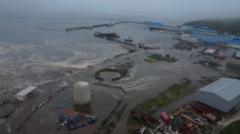An 8.8 magnitude earthquake has struck off the coast of Russia’s Kamchatka Peninsula, leading to tsunami alerts being issued across the Pacific, raising concerns for millions. Occurring at approximately 11:25 AM local time (00:25 AM BST), this powerful earthquake is now reported to be among the strongest ever recorded.
In response to the potential tsunami threat, evacuations have been ordered in significant areas, including Japan, parts of the US west coast, and locations across several countries such as China, the Philippines, Indonesia, New Zealand, and even as far as Peru and Mexico.
Live footage has shown significant waves crashing into buildings in Severo-Kurilsk, Russia, suggesting that local infrastructure, such as the port and fish processing facilities, have sustained damage and flooding. The power grid in the Sakhalin region has also been affected.
In Japan, authorities have called for the evacuation of roughly 1.9 million individuals, urging them to ascend to higher ground. Some residents have resorted to seeking safety atop buildings, particularly in Hokkaido, as they prepare for the potential impact of the tsunami.
In Hawaii, officials are monitoring the situation amid warnings of possible 10-foot waves making landfall; however, Governor Josh Green confirmed that a substantial wave has not yet been observed. Authorities anticipate it will take additional hours before they can confirm an “all clear.”
Experts are currently assessing the extent of damage that could follow, as tsunami waves travel across the Pacific. Chris Goldfinger, a Marine Geology Professor at Oregon State University, remarked on the unpredictability of the situation. "Each country is likely to experience a different response to the tsunami depending on its specific geography and the pathway taken by the energy radiating from Kamchatka," he explained.
The earthquake’s time of occurrence at 11:25 AM local time correlates with projected tsunami wave arrivals in British Columbia and California at 12:20 AM local time (09:20 AM BST), followed by Nome, Alaska, at around 03:20 AM local time (12:20 PM BST).
The depth of the earthquake has been recorded as relatively shallow at 19.3 km (12 miles), making it particularly impactful, with the US Geological Survey classifying it as one of the most severe earthquakes, tied for sixth place in historical records. Comparatively, the record for the most severe earthquake remains the 2004 Indian Ocean event, which claimed over 227,000 lives.
As rescue efforts ramp up, officials remain on high alert, keeping track of the situation as it develops across the affected regions.
In response to the potential tsunami threat, evacuations have been ordered in significant areas, including Japan, parts of the US west coast, and locations across several countries such as China, the Philippines, Indonesia, New Zealand, and even as far as Peru and Mexico.
Live footage has shown significant waves crashing into buildings in Severo-Kurilsk, Russia, suggesting that local infrastructure, such as the port and fish processing facilities, have sustained damage and flooding. The power grid in the Sakhalin region has also been affected.
In Japan, authorities have called for the evacuation of roughly 1.9 million individuals, urging them to ascend to higher ground. Some residents have resorted to seeking safety atop buildings, particularly in Hokkaido, as they prepare for the potential impact of the tsunami.
In Hawaii, officials are monitoring the situation amid warnings of possible 10-foot waves making landfall; however, Governor Josh Green confirmed that a substantial wave has not yet been observed. Authorities anticipate it will take additional hours before they can confirm an “all clear.”
Experts are currently assessing the extent of damage that could follow, as tsunami waves travel across the Pacific. Chris Goldfinger, a Marine Geology Professor at Oregon State University, remarked on the unpredictability of the situation. "Each country is likely to experience a different response to the tsunami depending on its specific geography and the pathway taken by the energy radiating from Kamchatka," he explained.
The earthquake’s time of occurrence at 11:25 AM local time correlates with projected tsunami wave arrivals in British Columbia and California at 12:20 AM local time (09:20 AM BST), followed by Nome, Alaska, at around 03:20 AM local time (12:20 PM BST).
The depth of the earthquake has been recorded as relatively shallow at 19.3 km (12 miles), making it particularly impactful, with the US Geological Survey classifying it as one of the most severe earthquakes, tied for sixth place in historical records. Comparatively, the record for the most severe earthquake remains the 2004 Indian Ocean event, which claimed over 227,000 lives.
As rescue efforts ramp up, officials remain on high alert, keeping track of the situation as it develops across the affected regions.



















